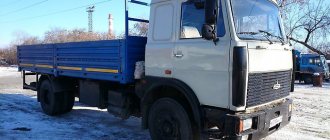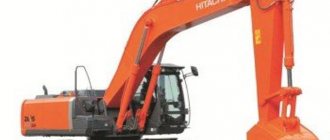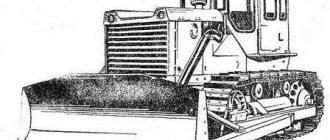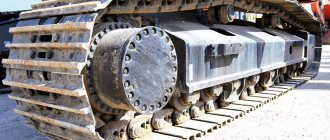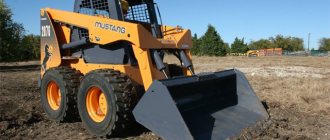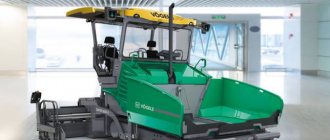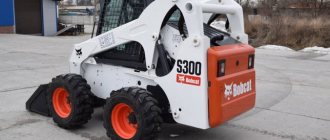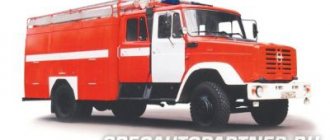The name ZIL-4333 is given to a family of medium-duty trucks with rear axle drive. There were on-board versions and a chassis designed for mounting various superstructures. The equipment has a reduced wheelbase, which improves maneuverability. The Likhachev plant produced several modifications of the machine, on which various power units were installed.
Technical characteristics of the ZIL-4333 truck and similar medium-duty vehicles
The name ZIL-4333 is given to a family of medium-duty trucks with rear axle drive. There were on-board versions and a chassis designed for mounting various superstructures. The equipment has a reduced wheelbase, which improves maneuverability. The Likhachev plant produced several modifications of the machine, on which various power units were installed.
Chassis wheel components and suspension
In ZIL-433360 the drive is on the driving rear wheels, the direction of movement is selected by changing the angle of rotation of the front wheels. In the factory configuration, the machine has seven disc-type wheels :
- two front wheels;
- double rear;
- one spare, suspended on the right side of the frame.
The wheel rims are mounted on the axle flanges with eight studs. The work of replacing tubes and tires is made easier by the existing split locking rings, which can be easily removed from one side of the rim.
With wheel sizes 7.0-20 and radial tube tires 260R508, it is difficult to change the tube without such a design.
The suspension of the front axle and rear axle is of a dependent type, which is explained by the presence of rigid beams on both wheel sets. Each is attached to the frame side members on a pair of semi-elliptical springs.
They perform a guiding function, and the more loaded rear ones are reinforced with additional sheets, and a telescopic hydraulic shock absorber is included with each front one.
Device and characteristics
The design of the truck is based on a shortened frame. The front beam is mounted on springs, which are complemented by 2-way hydraulic shock absorbers. The rear axle has a standard suspension for ZIL products, which includes main and additional springs.
The following power units were used:
- 185-horsepower diesel ZIL-645, having a cylinder volume of 8.74 liters;
- boosted to 200 hp version of the ZIL-6454 diesel engine, cylinder capacity 9.56 l;
- petrol V-shaped engine with a power of 150 hp;
- experimental diesel ZIL-0550, which had a cylinder volume of 6.28 liters and developed 132 hp.
The performance characteristics of the vehicles differ depending on the engine type, but the load capacity remains the same (6830 kg for the chassis and 6000 kg for the onboard version). The most widespread cars are those with gasoline engines, which were produced before 2005-07. The trucks were equipped with a 170-liter fuel tank and consumed about 26 liters of gasoline per 100 km (at a speed of 60 km/h).
A single-disc dry friction clutch is used to transmit torque. The gearbox is 5-speed, equipped with 2 synchronizers for 2-3 and 4-5 speeds. Switching is carried out by a lever mounted on the cover of the unit. The rear axle is equipped with a 1-stage bevel gearbox with a hypoid tooth profile. There are versions with an old bridge design, which is equipped with a 2-speed gearbox.
The gearbox has space for installing a power take-off gearbox. The unit is designed to connect gear oil pumps of an additional hydraulic system. Fluid supplied under pressure is used to drive additional equipment. For example, such a pump is used on automobile towers PART 28 or PSS 131-22, built on the basis of the ZIL-43336 1 chassis.
Between the output shaft of the gearbox and the shank of the main pair there is a cardan shaft equipped with hinges on needle bearings. The shaft, made of thin-walled pipe, consists of 2 sections. To reduce vibrations, an additional support support is used.
Machine Specifications:
- length (chassis) - 6620 mm;
- wheelbase - 3800 mm;
- width (along the cabin wings) - 2380 mm;
- front overhang - 1153 mm;
- height - 2580 mm;
- ground clearance (to the axle housing) - 220 mm;
- permissible vehicle weight - 11000 kg.
- design speed - 90 km/h.
The brake system is pneumatically driven and equipped with drum wheel mechanisms. The system includes several receivers with a capacity of 20 liters each. The design of the units includes drain valves designed to remove condensate.
The family of machines included the following modifications:
- chassis with a 2-row cabin, designed for installation of fire-fighting equipment;
- flatbed truck;
- export version for temperate climates; a tropical version of the truck was also produced separately;
- chassis for installing specialized add-ons.
All versions used an all-metal cabin, equipped with a separate seat for the driver and a sofa for 2 passengers.
Load capacity, axle loads, brakes and other operating parameters
When the vehicle's curb weight is less than 4.5 tons, the load on its axles is:
- on the front - no more than 2.21 tons;
- on the rear - less than 2.3 tons.
The carrying capacity of a single vehicle reaches more than 6 tons. In this case, with a maximum weight of about 11 tons, the loads on the axles change and amount to 3 and 8 tons for the front and rear, respectively.
To ensure driving safety, holding on a steep slope, stopping or reducing speed, the model uses combined brakes:
- main transmission;
- wheeled, drum type.
They are controlled by a proven three-circuit circuit, including:
- a pneumatically controlled service brake system
- parking and spare brake systems , also with pneumatic control of the main transmission circuit and wheel drum pads.
The car is equipped with an anti-lock braking system (ABS), which prevents skidding on slippery roads caused by possible wheel locking during braking.
In the rear part of the frame it is possible to install a combined valve for connecting the control system of the trailer brakes of a road train.
Operating features and technical characteristics of KamAZ-43114 can be found in our article. And here you will find a description of the Viking cultivator.
After reading the following information https://spez-tech.com/tehnika/gruzovie-avto/kraz/opisanie-i-harakteristiki-255.html, you will become aware of the main technical characteristics of the KrAZ-255 vehicle.
Prices and analogues
The cost of onboard vehicles on the secondary market is 130-150 thousand rubles. Vehicles equipped with a tank for transporting petroleum products are valued at 240-260 thousand rubles. For lovers of scale models, SSM has released copies of a truck, reduced by 43 times. You can become the owner of such a model for 2-4 thousand rubles.
ZIL-130 or 4331 trucks, as well as GAZ-3307, have similar characteristics. The MAZ-5335 and KamAZ-5320 vehicles can also be considered as competitors. But the equipment is less maneuverable and has a load capacity of 8-10 tons.
ZIL 4333
ZIL 4333 is a medium-duty truck, produced in various variations. The truck can be equipped with a variety of add-ons, which allows you to expand its scope of application.
This model was built on the basis of the popular ZIL 4331 and is essentially its modification. Distinctive features of the ZIL 4333 version are the presence of a shortened wheelbase and several power units, including the ZIL-645; ZIL-508.10 and ZIL-508.300. But in terms of appearance, both models are completely identical.
The great popularity of ZIL 4333 trucks is primarily due to their more compact overall dimensions, which has a positive effect on maneuverability. Thus, this truck can be used effectively in urban environments and at the same time transport fairly large volumes of cargo. In this regard, its modified versions are currently being produced with indexes 433302, 433360, and 433362, but they are already equipped with diesel engines.
Let's sum it up
Having completed production of ZIL-4331 in 2004, the manufacturer did not leave the car without a means of subsistence. Thanks to this, the truck remains popular due to its ease of maintenance. Of course, the power units are quite uneconomical and the load capacity is relatively small, but this does not prevent the car from still being popular in many areas.
Fuel truck ZIL-4331
When purchasing this model, you will have to fork out an amount of 200 to 2500 thousand rubles. In this case, the buyer receives a version produced in 1995-2004 with low mileage and in excellent condition. All that remains is to ensure quality care and use all the positive aspects of this car.
Modifications
The ZIL 4333 truck has a large number of modified versions produced in different periods. This list includes:
- Modification ZIL-433100. It is a standard version with a wheelbase of 4500 millimeters in length and a ZIL-645 engine;
- Modification ZIL-433102. This model was produced in the form of a chassis, on which various add-ons were later installed. It has a wheelbase of 4500 millimeters in length and a ZIL-645 engine;
- Modification ZIL-433104. It is also a chassis, but intended for the construction of fire engines. In technical terms, the modification is practically no different from previous versions and has a 4500 mm wheelbase and a ZIL-645 power unit;
- Modification AC-3-40. As a basis, this version uses a modification of ZIL-433104. ATs-3-40 is a fire fighting tanker. The wheelbase and engine remained unchanged;
- Modification AC-40-63B.01. The model ZIL-433362 was chosen as the basis for this modification. This is also a fire truck tanker. However, unlike the previous version, it uses a shortened wheelbase of 3800 millimeters;
- Modification ZIL-433110. It is a variation of the basic version of ZIL-4331, but is equipped with a ZIL-508.10 power unit. The wheelbase remains the same and is 4500 millimeters;
- Modification ZIL-433116. It is also a basic variation of the ZIL-4331 truck, equipped with a ZIL-509.10 power unit;
- Modification ZIL-43314B. It is a long-wheelbase onboard modification equipped with a ZIL-6454 power unit. The wheelbase of this truck has a length of 6100 millimeters;
- Modification ZIL-4332A. It is a special variation with a wheelbase extended to 5600 mm. Under the hood of such a truck there is a ZIL-645 engine;
- Modification ZIL-433302. It is a standard short-wheelbase version of the ZIL-4333 chassis, on which various superstructure options can be installed. The wheelbase length is 3800 millimeters;
- Modification ZIL-433360. It is a version of the truck equipped with a ZIL-508.10 engine. Has a wheelbase shortened to 3800 mm;
- Modification ZIL-433362. It is a short-wheelbase chassis with a ZIL-508.300 engine under the hood. The length of the wheelbase in this modification is 3800 millimeters;
- Modification ZIL-442100. It is a truck tractor. The version uses a ZIL-645 power unit. The wheelbase length is 3800 millimeters;
- Modification ZIL-442160. It is a truck tractor with a wheelbase shortened to 3300 mm and a ZIL-508.10 engine;
- Modification ZIL-442300. It is a truck tractor with a wheelbase extended to 4500 mm. The cabin of this modification is equipped with a berth.
General information
The history of the creation of the ZIL 4331 car begins in the 1970s. At that time, the USSR experienced a serious shortage of new productive equipment with high performance characteristics. The situation was entrusted to the specialists of the Likhachev plant to correct it. Together with representatives of the Kama Automobile Plant, they developed a fundamentally new model, which was based on one of the KamAZ modifications. The truck featured improved lighting, a new engine and a more modern design. The result of our collaboration was amazing. Specialists have created a new car with high reliability and cross-country ability.
The debut prototype was presented in 1977. He was destined to become the founder of a new family of products for the plant - diesel trucks. In the early 1980s, the vehicle was assigned the ZIL 4331 index. The car was finalized until 1985, after which the final design was approved. In 1987, the ZIL 4331 family entered the production line. The first versions received a 150-horsepower ZIL 508.10 gasoline unit, complemented by a 5-speed manual transmission. Later, diesel modifications appeared. For the model, an atmospheric diesel 165-horsepower ZIL 165 unit with volume-film mixture formation was developed. It worked in tandem with a mechanical synchronized 9-speed transmission.
The appearance of the car turned out to be quite standard. Its outline resembled a large rectangle. In front there was an unusual radiator grille located quite high. It took up a lot of space. Mud flaps were installed on the sides, which sharply moved away from the general body. Wheels were hidden in the depths. The ZIL 4331 bumper protruded slightly forward and was made of durable metal, serving as additional protection. The ends of the bumper covered the entire body, protecting the cabin from accidental damage. The cabin itself had angular outlines.
Important Design features of common tow trucks with partial loading of a vehicle
The vehicle received a dump compartment, which allowed it to transport various cargoes. The car easily handled large amounts of fertilizer, gravel, sand, crushed stone, stones, wood and even transported heavy metal structures. Later, modifications appeared that made it possible to transport liquid concrete over short distances. No other car had such characteristics at that time.
ZIL 4331 was modernized several times, and the number of different modifications based on this model was constantly increasing. The most interesting version came out in 1992. The car with a separate seat allowing 2 passengers to rest quickly found its buyer. The model was equipped with new side fairings and a powerful 9.55-liter unit (200 hp). Subsequent transformations concerned the installation of more advanced cabins on the old generation chassis.
In total, there were several dozen modifications of the ZIL 4331. The most notable of them:
- ZIL 433100 – basic version with ZIL 645 engine;
- ZIL 433102 – chassis of the base model;
- ZIL 432900 – short-wheelbase modification with a diesel engine;
- ZIL 433104 – chassis for a fire truck;
- ZIL 433116 – basic modification for export;
- ZIL 4332A - long-wheelbase version with a ZIL 645 engine (the model was not serially produced);
- ZIL 442100 - a truck tractor with a ZIL 645 engine and a wheelbase of 3800 mm;
- ZIL 442160 – truck tractor with a ZIL 645 engine and a wheelbase of 3300 mm;
- ZIL 442300 is a truck tractor with a ZIL 645 unit, a wheelbase of 4500 mm and a sleeper cabin.
ZIL 4331 had a universal body type, allowing it to transport various bulk materials, liquids and solids. Thanks to this ability, the car was used in various fields. Unpretentiousness and high reliability made the model popular in construction, agriculture and forestry, and among public utilities.
Cabin
Compared to its predecessor, which is the ZIL 130, this model has a more spacious cabin. However, the level of comfort has increased only slightly. Inside there is a driver's seat and a double passenger sofa.
In the 1990s, in addition to the standard three-seat cabin, an enlarged one with a sleeper appeared. But this type was used on certain modifications of the truck.
The cabin is held on the frame by four shock absorbers, which slightly smooth out shaking when moving. The design may well boast a large glass area, again in comparison with the ZIL 130. But since a fairly massive hood is used here, the front part is not as visible as the sides, but one gets used to it over time.
For operation in winter conditions, the cabin is equipped with a heating system, and it is quite effective. As for sound insulation, it is average, but still not so noisy in the cabin.
Engine access
To access the power unit, the designers used a completely new solution for its time. All front elements, which are a single piece, use hinges that allow this structure to be folded forward. From the point of view of repair and maintenance, this solution turned out to be very convenient, since it provided mechanics with full access to the engine and all other components located in the engine compartment.
However, there are also some disadvantages here, which is why the method was revised and on newer versions a standard hood appeared that folds up and back.
Tuning
Tuning involves carrying out a number of works to improve transport characteristics and increase the level of comfort while driving.
For example, you can make the driver's cabin more comfortable. To do this, you will need to install sound insulation to reduce the level of audibility in the cabin during work. You can install a pneumatic seat that can be adjusted in height, making the driver less tired.
For a smoother ride of the vehicle off-road, it is recommended to install an air suspension or replace the shock absorbers. Thanks to this, the driver will practically not feel any unevenness in the road.
Specifications
Engine
The range of installed power units consists of three main options, borrowed from the ZIL-4331 model:
ZIL-645. It is a standard solution for the ZIL 4333 truck. This is a V-shaped eight-cylinder power plant running on diesel fuel.
Characteristics of ZIL-645:
- Working volume – 8.76 l;
- Maximum power – 185 hp;
- Cylinder diameter – 100 mm;
- Piston stroke – 115 mm;
- The compression ratio in the combustion chamber is 18.5;
- Maximum torque – 510 Nm (at 1400-1600 rpm);
- Cooling is liquid.
ZIL-508.10. It is an eight-cylinder petrol power plant with a V-shaped cylinder arrangement. This engine is liquid cooled and has a carburetor fuel system.
Characteristics of ZIL-508.10:
- Working volume – 5.97 l;
- Maximum power – 150 hp;
- Cylinder diameter – 100 mm;
- Piston stroke – 95 mm;
- The compression ratio in the combustion chamber is 7.1;
- Maximum torque – 402 Nm (at 1800-2000 rpm);
- Cooling is liquid.
Brake system
The model has a pneumatic brake system with two circuits. Drum brakes are installed on all wheels. The front pads are 100 millimeters wide, while the rear ones are 140 millimeters wide.
The parking brake is provided by energy accumulators that block the rear wheels.
dimensions
- Total length – 6620 mm;
- Full width – 2380 mm;
- Total height – 2580 mm;
- Wheelbase length – 3800 mm;
- Front overhang height – 1153 mm;
- Ground clearance – 220 mm;
- Front track width – 1930 mm;
- The rear track width is 1850 mm.
Peculiarities
Among the main features of the ZIL 4333 model, the following should be noted:
- Lubrication points. For more convenient service, the number of points has been reduced;
- Brakes. For its time, the truck's braking system was quite effective. Moreover, it has a system for automatically adjusting the pads depending on their wear;
- Maintainability. Despite the fact that the ZIL 4333 is no longer produced, finding any spare parts for it even now will not be difficult. In addition, the design is made as simple and understandable as possible, which allows repair work to be carried out practically in the field;
- Interior sealing. The interior of the car is very well sealed, so that when working in dusty conditions, dust and other particles do not get inside;
- Seat belts. Since the cabin has three seats, the designers used seat belts for each of them.
- Maneuverability and maneuverability. Compact overall dimensions allow the truck to be used in conditions of limited free space, and the high ground clearance and short wheelbase provide it with excellent cross-country ability even in off-road conditions, although not severe, since all-wheel drive is still missing.
According to many drivers, the ZIL 4333 is in many ways superior to its predecessor ZIL-130. The truck has a contactless ignition system, a more comfortable driver's seat, more convenient access to the power unit and many other components located in the engine compartment and improved visibility.
Although the ZIL 4333 truck has a large number of excellent reviews, it still could not gain much popularity in the Russian market. Moreover, it is even significantly inferior to its similar foreign-made models. This is primarily due to high fuel consumption, which made it uneconomical for many consumers to use it. In addition, it has a low load capacity. However, due to ease of maintenance and low cost, ZIL 4333 has found a niche in some areas of industry, especially in rural areas.
Flaws
This model also has its drawbacks. The first models used a single design for the front of the cabin, acting as a hood. Of course, in terms of access to the engine, this solution turned out to be very successful, but only if the geometry of the truck frame is not violated. If damaged, the hood was difficult to open and close. But later, in connection with this, the designers returned to the usual alligator hood. Also, the ZIL 4333, produced in the 1990s, has poor build quality, but this problem also affected other domestic manufacturers at that time.
Since serial production of the ZIL 4333 truck has been discontinued, it is currently impossible to purchase completely new equipment. However, many used car listings offer the secondary market. The cost of such options varies from 100 thousand to 600 thousand rubles. The price tag is affected by factors such as year of manufacture, type of installed superstructure, technical condition, and mileage.
Model frame
The truck frame is that inconspicuous but important basis that carries the load from the installed units, perceiving it when the vehicle begins to move.
This is probably the only element of the machine that works without replacement throughout its entire service life.
In ZIL-433360, the design of the supporting base includes:
- frame spars , made in the form of all-stamped steel beams with a channel section profile of variable height, the largest in the middle part of each longitudinal element, since here they experience the main loads;
- five cross members , also stamped from steel of the same grade, connecting the structure, the joints are riveted.
Brackets are attached to the spars and beams for further assembly of units, mechanisms, suspensions, monitoring and control systems.
The location of the beams along the length of the side members is uneven. The rear cross member, which has a coupling device, is mounted on the ends of the longitudinal elements.
Important! On the front buffer there are spaces for a bumper with built-in lighting devices (headlights, turn signals and dimensions) and a towing hook.
The first beam is shifted relative to the beginning of the side members and has seats for installing the motor.
ZIL-4331
- Car make: ZIL
- Country of origin: USSR
- Year of manufacture: 1986
- Body type: Truck
A modern replacement for the legendary ZIL-130 truck. Developed to special order, the “4331” models have a wide range of capabilities, but are not without their drawbacks, which everyone has. The Likhachev plant in this version presented the first diesel truck produced in Russia. The entire ZIL model range.
general information
The car was designed at the AMO Design Bureau "Plant named after. Likhachev" as the actual successor to the ZIL-130.
In its basic version, the 360 is designed for transporting all kinds of cargo by a single vehicle or as part of a road train on any type of road.
This general-purpose vehicle, with a 4x2 wheel arrangement and a (now classic) simple transmission option, rolls out of the assembly shop with the body installed.
The height of the loading platform made of durable wood with a protective layer is only 1.45 m. There are folding sides made of metal or the same material as the base.
Do you know the distinctive features of the new Case combines of various series? In this article you can understand the main modifications of the MAZ-5334 and their technical characteristics.
The useful volume inside the standard body of a single car along the side is at least 5 cubic meters (3.75x2.33x0.58). And the hood layout makes the truck simple, compact and maneuverable.
With a base of no more than 3.8 m and a length from bumper to tailgate of about 6.8 m, the car turns around a radius of less than 7 m. As its creators planned, the ZIL-433360 turned out to be a worthy and sought-after replacement for its honored predecessor.
Car history
Since 1962, the Likhachev Plant in Moscow has produced a truck for the national economy under the ZIL-130 brand. The truck was extremely popular and practical, but was inferior to its classmates due to high fuel consumption. At the end of the seventies, the plant began developing a more economical model with a diesel engine. Namely, in the 70s, the designers of the Likhachev plant received the task of developing two advanced trucks with different load capacities.
The models were supposed to run on diesel fuel. Initially, the car was designed by ZIL specialists, but after the design was created, the documentation was transferred to Naberezhnye Chelny. In 1986, the first ZIL-4331 began to roll off the assembly line. It was this model that was intended to replace the ZIL-130. Shortly after the launch of the project, the debut version of this model with a double cab was presented, as well as a chassis designed for special vehicles. Later, specialists from the Likhachev plant created a racing version of the truck, which resembled the original only in appearance.
History and purpose of the truck
In the mid-1950s, work began at the Likhachev plant to create an all-wheel drive truck for the army. Together with the development of the ZIS 157, specialists tried to design a fundamentally new machine. Most of the ideas used for the technology have already been implemented and have proven themselves successfully. At the same time, the car also had a number of obvious shortcomings. In 1956, the developers presented an experimental ZIS 131 truck, unified with the ZIS 130 model.
At that time, the company experienced certain difficulties with the production of parts and assemblies that were not serial, therefore, in 1958, a transitional version of the ZIL 165 was introduced. In terms of technical characteristics and design, the car was similar to the experimental version. However, testing showed a large number of flaws in the product design. As a result, the plant decided to stop further development of the model and direct all efforts to finalizing the ZIL 131. From that moment on, the car began to be improved. In 1959, tests were carried out on a pilot batch of trucks, after which mass assembly was expected to open, but various difficulties did not allow this to happen.
In 1960, the company released the ZIL 132 model with higher cross-country ability, but it did not go into production. In 1964, the plant began a global renewal of its production program. The changes affected the interior and exterior of the trucks. The modernization also affected the ZIL 131. Initially, the model was supposed to be unified with the ZIL 130, but military representatives stopped such attempts. With the ornate radiator trim and blown front fenders, it would be very difficult in field conditions.
The first production batch of ZIL 131 was produced in 1967. Over the course of 8 years, engineers significantly improved the car, making it a worthy replacement for the ZIL 157. It was noticeably superior to its predecessor in terms of comfort, load capacity, maneuverability and speed. In 1974, the product was awarded the State Quality Mark.
In its original variation, the model lasted for almost 20 years. In 1986, the Likhachev plant showed its modernized version - ZIL 131N. The car was produced with diesel (modification ZIL 131N1 and ZIL 131N2) and gasoline (modification ZIL 131N) engines. A year later, production of the model began at the Ural Automobile Plant.
In addition to the basic design, the truck had basic modifications. Among them:
- ZIL 131A – version with unshielded unsealed electrical equipment;
- ZIL 131V – truck tractor. On its basis, the ZIL 137 road train was produced, consisting of a truck tractor and a 10-ton trailer;
- ZIL 131S is a car for cold climates.
The ZIL 131 chassis, which was used for mounting equipment, became widespread. Based on the car, oil dispensers, fuel tankers, tank trucks, versions with van bodies, special heavy-duty vehicles, auto repair shops and other types of equipment were produced.
In Moscow, production of the ZIL 131 was completed in 1994. In the brand's model range it was replaced by ZIL 4334. However, production of the truck continued at the Ural Automobile Plant. Formally, it ended only in 2002. At the same time, the Ural Automobile Plant continued to produce the AMUR 521320 model, which was a full-fledged analogue of the ZIL 131N.
The truck had a large margin of safety and excellent traction qualities. It could be used on any roads at temperatures from -40 to +50 degrees. It was these qualities that attracted consumers. ZIL 131 was used not only on the territory of the USSR. The model was actively exported to the Warsaw Pact states and countries friendly to the Union. This technique was ideal for transporting personnel and army cargo. The ZIL 131 was most widely used in the military sphere, where versions with three-stage air filtration and shielded electrical equipment were supplied, capable of traveling in critical weather and road conditions.
Cabin and body
First of all, the appearance of the cabin has changed. It acquired angular, clearly defined outlines without smooth transitions. The body is made entirely of metal and has a common base. However, its layout is not entirely standard. The main difference is that the fenders, hood and front grille are made from one rigid piece.
Access to the engine is provided by lifting this structure up and forward on hinges that are attached to the front bumper on the vehicle's power frame. At the same time, it has become very convenient to repair the engine; access to all engine systems is available. Over time, this method was abolished due to some inconveniences in operation.
In subsequent versions of the model, the hood opens in the usual “alligator” way. At the front of the ZIL-4331 truck, a new front bumper is installed, into which headlights and turn signals are mounted. Moreover, they are structurally located in such a way that there is the least danger of damage in the event of an accidental collision. Inside, the cabin has become more comfortable.
The comfortable driver's seat is sprung and adjustable in all directions. Two passengers can sit side by side. The middle seat lifts up to create a table. The large glass area of the cabin and side mirrors allow you to fully control the road situation.
The ZIL cabin of the “4331” model is equipped with excellent heat and sound insulation, which allows you to talk inside the truck without raising your voice, and also not experience inconvenience due to cold weather. There are three seats, one of them is the driver's seat. One of the most popular was the modification with a berth, which appeared in the early 90s.
The model received a universal bumper “skirt”, fairings on the sides of the body and a drag foiler installed on the roof. ZIL-4331, in comparison with foreign analogues, stood out for its significantly lower cost. In addition to the cabin designed for three people, versions with a 2-row cabin version with 7 seats were also produced.
The ZIL-4331 flatbed body is a wooden platform with metal transverse base bars, with folding rear and side sides. The body design provides for the possibility of installing extension sides and an awning with a frame.
Video
The model received a cabin with rectangular outlines. The hood, fenders and radiator grille fit into one panel, which can be easily opened forward thanks to hinges.
In the 80s, the project acquired a new name. In addition, the design of the car has undergone changes. ZIL-4331 acquired an extended bumper of an original shape, a radiator lining made of lightweight plastic, an all-metal cargo platform and a lightweight front part. Some changes have occurred in the car's cabin. The driver's seat has received additional options.
The technical parameters of the model were also pleasing. The car accelerated to 100 km/h and had high load capacity.
Soon after the launch of the project, the debut version of the ZIL-4331 with a double cab was presented, as well as a chassis designed for special vehicles. Later, specialists from the Likhachev plant created a racing version of the truck, which resembled the original only in appearance.
One of the most popular was the modification with a berth, which appeared in the early 90s. The model received a universal bumper “skirt”, fairings on the sides of the body and a drag foiler installed on the roof. ZIL-4331, in comparison with foreign analogues, stood out for its significantly lower cost.
Subsequent changes concerned the cabin and transfer to the next generation chassis. The latest version, called ZIL-4331A, has acquired a new generator device and an “alligator” type hood, which makes it easier to open and close in case of damage and in cold weather.
Modifications of ZIL-4331:
- ZIL-433100 - basic model with a wheelbase of 4500 mm and a ZIL-645 engine;
- ZIL-433102 – standard chassis;
- ZIL-433104 – chassis for fire trucks;
- ZIL-433110 – basic modification with the ZIL-508.10 unit;
- ZIL-433116 – basic version with the ZIL-509.10 power plant;
- ZIL-43314B - long-wheelbase flatbed version with a ZIL-6454 engine with a wheelbase of 6100 mm;
- ZIL-4332A - a special version with an extended wheelbase (5600 mm) and a ZIL-645 engine;
- ZIL-4333 - short-wheelbase modification with a ZIL-645 engine and a wheelbase of 3800 mm;
- ZIL-433302 – short-wheelbase chassis;
- ZIL-433360 – model with a shortened wheelbase and the ZIL-508.10 power plant;
- ZIL-433362 - short-wheelbase chassis equipped with a ZIL-508.10 engine;
- ZIL-442100 – truck tractor with a wheelbase of 3800 mm and a ZIL-645 unit;
- ZIL-442160 – truck tractor with a wheelbase of 3300 mm and a ZIL-508.10 engine;
- ZIL-442300 is a truck tractor with a sleeper and an extended wheelbase (4500 mm).
All versions of the model were characterized by a rear-wheel drive, front-engine layout.
This is interesting: Characteristics of vehicles based on the universal truck chassis ZIL-433362: let’s look into it in detail
Specifications
Engine
It is ZIL-4331 that is considered the founder of the first Russian line of trucks with diesel power plants. Fuel consumption of ZIL 4331 is from 18 l/100 kilometers. If we talk about a road train, then its consumption already starts from 25 liters per hundred.
It is extremely rare, but still, you can find gasoline engines on trucks of the “4331” model. When operating a car with gasoline engines, consumption is approximately 30-36 liters per 100 km at a speed of 90-95 km/h and may vary depending on the load.
